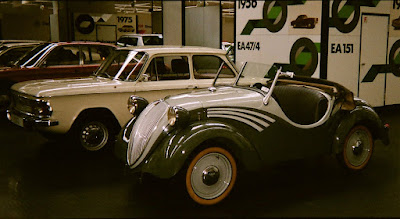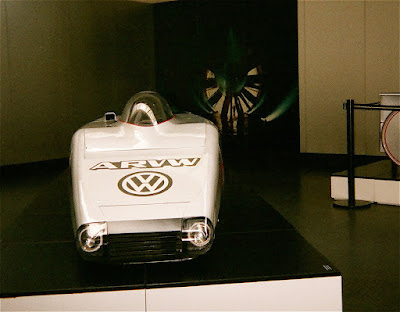Funkengroovin Wednesday - Scenes From A Museum, The Oddities and Egyptian Relatives
Trying to make up for lost posts during VB's return trip to Egypt and then the sudden Internet outage, VB presents another edition of Scenes from a Museum. And, yes, she knows it's not Wednesday anymore.
Previous Posts:
Scenes From A Museum, included Transporters
Scenes From A Museum, Beetles, had all Beetle photos.
All pics are digitized versions of photos taken during our trip to Germany, 1996, when we visited the Wolfsburg VW Museum.
(Below)VW Invader GT (?)

(Below) DKW, Baby Thunderbird:
"DKW cars in the 1950s were all based on characteristic 2-stroke engines which were gradually becoming obsolete and an aerodynamic body shell developed just before the War. Marketing these cars became more and more difficult and DKW desperately needed an image boost.
And so director William Werner, of US American origins, ordered his stylists one day in 1956 to design "a sportscar that has to look like a bomb". The stylists decided to check out what was on the market and ultimately came up with the 1000Sp; a German interpretation of the 1957 Ford Thunderbird with a non-removable coupe top not unlike that of the one-off 1956 Ford Thunderbird "Five-Window Hardtop" prototype." (Read and see much more about it on the link and here at Wiki.)
1965
"Daimler-Benz sold their shares in Auto-Union to VolksWagen Werke, who thereby got influence in Auto union. In 1965 DKW and AU 100 were removed from the manufacturing and a new Audi was introduced."

(Below L) Off White Car, NSU
(Below R) Predecessor to possibly the Wanderer W25 (VB's thinking this car is related to the Auto-Union line, but she's not exactly sure where. It took her several days of studious undertaking to come to this inconclusive guess.)
From Wiki: "The trademark of Auto Union was a symbol of four overlapping rings, symbolizing the four member companies (all four in a line, in an attempt to avoid confusion with the 5 Olympic rings). The trademarks and company names of the member companies - Horch, Audi, DKW and Wanderer - were continued; the four ring logo was used only in racing. The four ring logo of Auto Union is still a trademark, and now used by Audi."
 Talking about strange relationships, especially since VB is in Egypt:
Talking about strange relationships, especially since VB is in Egypt:
"In 1969, just as the car was about to be launched, NSU was taken over by Volkswagen, who integrated the Neckarsulm company with Auto-Union/Audi, which it had acquired in 1964." (Wiki)
From Marc's NSU Pages, NSU Ramses: (Check out more of the description, and pics at the link.)
"The NSU Ramses Utilica was the first car produced in Egypt, and was the result of a coorporation between the new egyptian car firm Egyptian Automotive Co., and the german NSU. The factory was located right next to the Great Pyramids. Plans were to produce around 10.000 cars a year, most of the work being manual labor.
Other models created by were the Ramses Limousine, and Ramses Gamila, a two-seater sport car with a vignale body."
The Independent ranks The Ramses as one of the, Top Ten African Cars, "Based first on the British Frisky and then the NSU Prinz. As the name suggests, made in Egypt. One of Colonel Nasser's pet projects in the 1950s."
Further on down the genealogical automobile road:
"Nasr, (Arabic: النصر, long form: El Nasr Automotive Manufacturing Company) is Egypt's state owned automobile company, founded in 1960 in Helwan, Egypt. Since 1979 the company has produced licensed versions of the Fiat 128 and 125, and in 1991 introduced a further range of Fiat designed cars licensed via the Turkish company Tofaş. In the early 2000s Nasr began producing the Florida range under license from Serbian manufacturer Zastava.
Nasr was a replacement for the short-lived Ramses automobile (also state produced), which suffered from poor design and performance. The Nasr was intended to be an affordable car for the average person of means (though it was still too expensive for a large proportion of the Egyptian population). The company's creation was also part of the general industrialization process initiated after the Egyptian Revolution of 1952, which would see millions of Egyptians flock to urban areas to gain work in newly built factories and industrial centers."
VB wonders if any of those NSU Ramses,the Ramses Limousine, and/or Ramses Gamila are still around. That would be interesting - possibly another post too. For now - back to the Museum.
(Below): The Beetle Trolley Car

(Below): Experimental - ARVW: Much better photo at Wiki.
Also, here:
"The ARVW (Aerodynamic Research Volkswagen) set two world records, and seven class records, for diesel vehicles at the high-speed track in Nardo, Italy. The fastest lap was completed at a speed of 362.07 km/h. This experiment was designed to provide detailed information on the effects of aerodynamics on fuel consumption at high speeds. The drag coefficient of the ARVW, the "Silver Cigar," is 0.15. The test concluded that the vehicle consumed 6 liters per 100 km, at 250 km/h, and at top speed, 13.61 liters per 100 km. In comparison, renowned sports cars required 38 liters of fuel for 100 km."

(Below): Stretch Beetle Convertible

No music video today. Music videos offered only on real Funkengroovin Wednesdays. BTW, spellcheck is still not working, and the Internet is still fairly slow - no fun watching videos when it takes over an hour to load them. (VB hasn't really tried lately, since it has turned into a frustrating ordeal.)
Previous Posts:
Scenes From A Museum, included Transporters
Scenes From A Museum, Beetles, had all Beetle photos.
All pics are digitized versions of photos taken during our trip to Germany, 1996, when we visited the Wolfsburg VW Museum.
(Below)VW Invader GT (?)

(Below) DKW, Baby Thunderbird:
"DKW cars in the 1950s were all based on characteristic 2-stroke engines which were gradually becoming obsolete and an aerodynamic body shell developed just before the War. Marketing these cars became more and more difficult and DKW desperately needed an image boost.
And so director William Werner, of US American origins, ordered his stylists one day in 1956 to design "a sportscar that has to look like a bomb". The stylists decided to check out what was on the market and ultimately came up with the 1000Sp; a German interpretation of the 1957 Ford Thunderbird with a non-removable coupe top not unlike that of the one-off 1956 Ford Thunderbird "Five-Window Hardtop" prototype." (Read and see much more about it on the link and here at Wiki.)
1965
"Daimler-Benz sold their shares in Auto-Union to VolksWagen Werke, who thereby got influence in Auto union. In 1965 DKW and AU 100 were removed from the manufacturing and a new Audi was introduced."

(Below L) Off White Car, NSU
(Below R) Predecessor to possibly the Wanderer W25 (VB's thinking this car is related to the Auto-Union line, but she's not exactly sure where. It took her several days of studious undertaking to come to this inconclusive guess.)
From Wiki: "The trademark of Auto Union was a symbol of four overlapping rings, symbolizing the four member companies (all four in a line, in an attempt to avoid confusion with the 5 Olympic rings). The trademarks and company names of the member companies - Horch, Audi, DKW and Wanderer - were continued; the four ring logo was used only in racing. The four ring logo of Auto Union is still a trademark, and now used by Audi."
 Talking about strange relationships, especially since VB is in Egypt:
Talking about strange relationships, especially since VB is in Egypt:"In 1969, just as the car was about to be launched, NSU was taken over by Volkswagen, who integrated the Neckarsulm company with Auto-Union/Audi, which it had acquired in 1964." (Wiki)
From Marc's NSU Pages, NSU Ramses: (Check out more of the description, and pics at the link.)
"The NSU Ramses Utilica was the first car produced in Egypt, and was the result of a coorporation between the new egyptian car firm Egyptian Automotive Co., and the german NSU. The factory was located right next to the Great Pyramids. Plans were to produce around 10.000 cars a year, most of the work being manual labor.
Other models created by were the Ramses Limousine, and Ramses Gamila, a two-seater sport car with a vignale body."
The Independent ranks The Ramses as one of the, Top Ten African Cars, "Based first on the British Frisky and then the NSU Prinz. As the name suggests, made in Egypt. One of Colonel Nasser's pet projects in the 1950s."
Further on down the genealogical automobile road:
"Nasr, (Arabic: النصر, long form: El Nasr Automotive Manufacturing Company) is Egypt's state owned automobile company, founded in 1960 in Helwan, Egypt. Since 1979 the company has produced licensed versions of the Fiat 128 and 125, and in 1991 introduced a further range of Fiat designed cars licensed via the Turkish company Tofaş. In the early 2000s Nasr began producing the Florida range under license from Serbian manufacturer Zastava.
Nasr was a replacement for the short-lived Ramses automobile (also state produced), which suffered from poor design and performance. The Nasr was intended to be an affordable car for the average person of means (though it was still too expensive for a large proportion of the Egyptian population). The company's creation was also part of the general industrialization process initiated after the Egyptian Revolution of 1952, which would see millions of Egyptians flock to urban areas to gain work in newly built factories and industrial centers."
VB wonders if any of those NSU Ramses,the Ramses Limousine, and/or Ramses Gamila are still around. That would be interesting - possibly another post too. For now - back to the Museum.
(Below): The Beetle Trolley Car

(Below): Experimental - ARVW: Much better photo at Wiki.
Also, here:
"The ARVW (Aerodynamic Research Volkswagen) set two world records, and seven class records, for diesel vehicles at the high-speed track in Nardo, Italy. The fastest lap was completed at a speed of 362.07 km/h. This experiment was designed to provide detailed information on the effects of aerodynamics on fuel consumption at high speeds. The drag coefficient of the ARVW, the "Silver Cigar," is 0.15. The test concluded that the vehicle consumed 6 liters per 100 km, at 250 km/h, and at top speed, 13.61 liters per 100 km. In comparison, renowned sports cars required 38 liters of fuel for 100 km."

(Below): Stretch Beetle Convertible

No music video today. Music videos offered only on real Funkengroovin Wednesdays. BTW, spellcheck is still not working, and the Internet is still fairly slow - no fun watching videos when it takes over an hour to load them. (VB hasn't really tried lately, since it has turned into a frustrating ordeal.)






So what are you going to put in the mousetrap? I heard peanut butter is good. Good Luck. I am ok now that I don't put the bag out at night. And as for spell check - my blogger often has arabic mixed in the nav bar and my spell check hasn't worked since that introduced arabic. Short sighted of google to ASSUME that EVERYBODY blogging from the middle east would be using Arabic... don't you think?
ReplyDeleteOh and I love that green and white street train! I want a ride on it.
Peanut butter works great. It's sticky so the mouse / rat can't just grab it and run off, without tripping the latch.
ReplyDeleteThat Google problem with the Arabic script, even when I designate English as a preference is driving me crazy! It is soooo annoying! Even if I don't log out, but just close my browser, when I get back on it happens again - especially with Firefox, which I use for my posts (Safari has bugs in it that make it extremely difficult to use for uploading images and editing.)